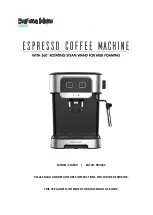
28
high altitude (more than 750 m) the dough
rises faster. The yeast can be reduced
in these cases by 1/4 to 1/2 of a teaspoon
to proportionally reduce its rising. The
same is true of places with particularly
soft water.
3. Adding and measuring the ingredients
and quantities
• Always put in first the liquid and the yeast
at the end. To avoid that the yeast acts
too fast (in particular when using the
timing function), contact between the
yeast and the liquid must be avoided.
• When measuring use the same
measuring units, that is to say use either
the measuring spoon supplied with the
bread baking machine or a spoon used
in your home when the recipes require
doses measured in tablespoons and
teaspoons.
• The measures in grams must be weighed
precisely.
• For the millimeter indications you can use
the supplied measuring beaker. The
abbreviations in the recipes mean:
EL = level tablespoonful (or large
measuring spoon)
TL = level teaspoonful (or small
measuring spoon)
g = grams
ml = milliliter
Packet = 7g dry yeast for 500 g of flour
– corresponds to 20 g of fresh yeast
1 OZ (Unze) = 28,35 g
• Fruit, nuts or cereal ingredients. If you
wish to add other ingredients, you can
do so in specific programs (see the
“Program Phase Timing” table), when
you here the acoustic signal. If you add
the ingredients too early, they will be
crushed during the kneading.
4. Recipes for the bread baking machine
The following recipes are for various
bread sizes. The total weight of the
ingredients should not exceed 1250
grams.
If no levels are specified in the recipe, it
means that they are not envisaged in the
proposed programs and that both small
and large quantities can be used.
5. Bread weights and volumes
• In the following recipes you will find exact
indications regarding the bread
weight.You will see that the weight of
pure white bread is less than that of
wholemeal bread. This depends on the
fact that white flour raises more and hence
limits need to be posed.
• Despite the precise weight indications
there may be slight differences.The actual
bread weight depends much on the air
humidity of the room at the moment of
the preparation.
• All breads with a substantial portion of
wheat reach a large volume and exceed
the container edge after the last rising in
the case of the highest weight class. But
the bread does not spill over. The part
of the bread outside the tin is more easily
browned compared to the bread in the
tin.
• When the RAPID or ULTRA RAPID
program is suggested for sweetbreads,
you can use the ingredients in smaller
quantities also for the SWEET BREAD
program to make a lighter bread.
6. Baking results
• The result of the baking depends on the
on-site conditions (soft water – high air
humidity –high altitude–consistency of
the ingredients, etc.). Therefore, the
recipe indications are reference points
which can be adapted.
If one recipe or another does not go
straight the first time, do not let yourself
be discouraged. Try to find the cause
and try it again by varying the proportions.
• If the bread is too pale after baking, you
can leave it to brown with the baking
program.
• It is recommended to bake a test bread
before actually setting the timing function
for use overnight so that you can make
the necessary changes if necessary.





































